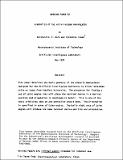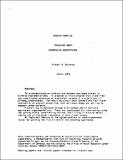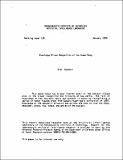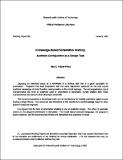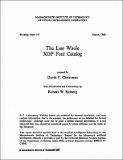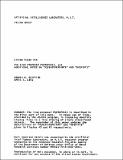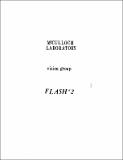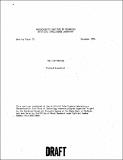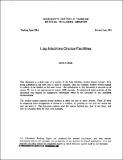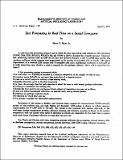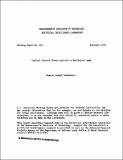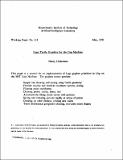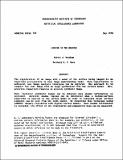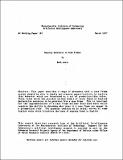Browsing AI Working Papers (1971 - 1995) by Title
Now showing items 129-148 of 291
-
Kinematics of the MIT-AI-VICARM Manipulator
(MIT Artificial Intelligence Laboratory, 1974-05)This paper describes the basic geometry of the electric manipulator designed for the Artificial Intelligence Laboratory by Victor Scheinman while on leave from Stanford University. The procedure for finding a set of joint ... -
Kinematics, Statics, and Dynamics of Two-D Manipulators
(MIT Artificial Intelligence Laboratory, 1975-06)In order to get some feeling for the kinematics, statics, and dynamics of manipulators, it is useful to separate the problem of visualizing linkages in three-space from the basic mechanics. The general-purpose two-dimensional ... -
Knowledge About Interfacing Descriptions
(MIT Artificial Intelligence Laboratory, 1974-03)This concentrates on interactions between knowledge stated in diverse representations. It proposes a vision program that classifies any complicated object as an elaborated instance of a simple on it already understands. ... -
Knowledge Driven Recognition of the Human Body
(MIT Artificial Intelligence Laboratory, 1976-01)This paper shows how a good internal model of the subject viewed aids in the visual recognition and following of key parts. The role of knowledge driven top-down tools and methods is shown by recognizing a series of human ... -
A Knowledge-Based Computer Animation System
(MIT Artificial Intelligence Laboratory, 1976-02)This paper reproduces part of a doctoral thesis proposal describing the design of a system capable of generating animated drawings in response to a simple story. The representation and interaction of the various sources ... -
Knowledge-Based Schematics Drafting: Aesthetic Configuration as a Design Task
(MIT Artificial Intelligence Laboratory, 1987-01)Depicting an electrical circuit by a schematic is a tedious task that is a good candidate for automation. Programs that draft schematics with the usual algorithmic approach do not fully exploit knowledge of circuit function, ... -
The L%LINES Package
(MIT Artificial Intelligence Laboratory, 1971)The program (L%LINES X Y) takes feature point output from the FP%FPOINTS program (q.v.) for horizontal and vertical scans (X and Y respectively); and outputs a list consisting of two lists of line segments, represented in ... -
The Last Whole XGP Font Catalog
(MIT Artificial Intelligence Laboratory, 1980-03) -
Laws for Communicating Parallel Processes
(MIT Artificial Intelligence Laboratory, 1976-11)This paper presents some "laws" that must be satisfied by computations involving communicating parallel processes. The laws take the form of stating restrictions on the histories of computations that are physically realizable. ... -
Laws for Communicating Parallel Processes
(MIT Artificial Intelligence Laboratory, 1977-05-10)This paper presents some laws that must be satisfied by computations involving communicating parallel processes. The laws are stated in the context of the actor theory, a model for distributed parallel computation, and ... -
The Line Proposer P%PROPOSE1, and Additional Notes on "F%FEATUREPOINTS" and "GVERIFY1"
(MIT Artificial Intelligence Laboratory, 1971-04-02)The line proposer P%PROPOSE1 is described in the first part of this memo. It makes use of links provided by the J%JOIN program, in proposing possibly missing lines in a line drawing of simple plane-faced objects. The ... -
The Line Verifier GVERIFY1
(MIT Artificial Intelligence Laboratory, 1971)A line verifier is presented which, given the co-ordinates of the end points of the hypothesized line, returns a (possibly) more accurate version of the end points, together with an estimate of the probability that there ... -
The LISP Machine
(MIT Artificial Intelligence Laboratory, 1974-11) -
Lisp Machine Choice Facilities
(MIT Artificial Intelligence Laboratory, 1981-06)This document is a draft copy of a portion of the Lisp Machine window system manual. It is being published in this form now to make it available, since the complete window system manual is unlikely to be finished in the ... -
List Processing in Real Time on a Serial Computer
(MIT Artificial Intelligence Laboratory, 1977-04-01)A real-time list processing system is one in which the time required by each elementary list operation (CONS, CAR, CDR, RPLACA, RPLACD, EQ, and ATOM in LISP) is bounded by a (small) constant. Classical list processing ... -
Logical Control Theory Applied to Mechanical Arms
(MIT Artificial Intelligence Laboratory, 1979-02)A new control algorithm based upon Logical Control Theory is developed for mechanical manipulators. The controller uses discrete tesselations of state space and a finite set of fixed torques to regulate non-rehearsed ... -
Logo Turtle Graphics for the Lisp Machine
(MIT Artificial Intelligence Laboratory, 1981-05-05)This paper is a manual for an implementation of Logo graphics primitives in Lisp on the MIT Lisp Machine. The graphics system provides: Simple line drawing and erasing using "turtle geometry" Flexible relative and absolute ... -
Looking in the Shadows
(MIT Artificial Intelligence Laboratory, 1976-05)The registration of an image with a model of the surface being imaged is an important prerequisite to many image understanding tasks. Once registration is achieved, new image analysis techniques can be explored. One approach ... -
MAPPER Information
(MIT Artificial Intelligence Laboratory, 1974-09)This working paper describes a program on the Mini-Robot PDP-11 which is used for looking at picture files created by the VIDIN program. It may be used by ITS vision programmers to examine Vidicon picture files before ... -
Mapping Sentences to Case Frames
(MIT Artificial Intelligence Laboratory, 1977-03)This paper describes a range of phenomena that a case frame system should be able to handle and proposes generalizations to capture this behavior which are formulated as a set of production-like rules. These rules allow ...

